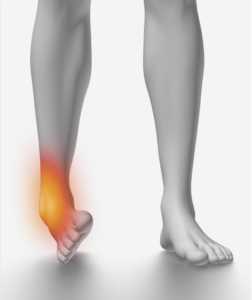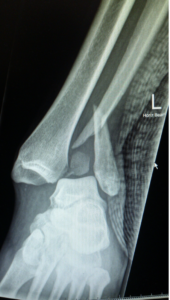 The ankle is a complex joint made up of multiple pieces working together to allow the foot to move. All these moving parts also make the ankle prone to injury. In fact, ankle sprains and fractures (breaks) are among the most common injuries for Americans, impacting millions each year. Often, these injuries are exercise or sports-related. Furthermore, simple falls, twists, or missteps are common causes of each. Both injuries may make it difficult to bear weight. They can each also result in bruising, swelling, and tenderness. In fact, the two injuries are so similar they are often mistaken for one another. So, how can you tell an ankle sprain from an ankle fracture? We’ll discuss this and more in the following post. Also, don’t miss our recent post about how to tell the difference between a sprained ankle and a rolled ankle.
The ankle is a complex joint made up of multiple pieces working together to allow the foot to move. All these moving parts also make the ankle prone to injury. In fact, ankle sprains and fractures (breaks) are among the most common injuries for Americans, impacting millions each year. Often, these injuries are exercise or sports-related. Furthermore, simple falls, twists, or missteps are common causes of each. Both injuries may make it difficult to bear weight. They can each also result in bruising, swelling, and tenderness. In fact, the two injuries are so similar they are often mistaken for one another. So, how can you tell an ankle sprain from an ankle fracture? We’ll discuss this and more in the following post. Also, don’t miss our recent post about how to tell the difference between a sprained ankle and a rolled ankle.
First, we will explain what ankle sprains and ankle fractures are. Then, we’ll go over the differences between the two, including how they are treated. Finally, we’ll let you know when it’s time to see a doctor.
 What is an ankle sprain?
What is an ankle sprain?
An ankle sprain refers to damage to a ligament, which is the connective tissue between bones. The ligament can be partially or completely torn if an injury occurs. Often sprains are rated as a grade 1, 2, or 3 depending on how many ligaments are involved and whether those ligaments are stretched, partially torn, or completely torn.
What is an ankle fracture?
An ankle fracture refers to a break in a bone. The fracture can be a non-displaced crack in the bone, meaning the bone is still aligned, but can also be displaced resulting in a disruption in the normal alignment of the bone. Most often, a broken ankle is caused by a fall, car accidents, high-impact sports, or injuries where excessive force is involved.
How can you tell the difference between the two?
You now know an ankle sprain refers to damage to the ligament (fibrous tissue) between bones and an ankle fracture is an actual break in the bone. But with that information alone, it is still very difficult to determine which injury you’ve experienced. So, if you’re still asking, “Is my ankle sprained or broken?” try answering the following questions:
- Did you hear something at the time of the injury? Most often, a sprain occurs silently, or maybe with a ‘pop’ sound in severe instances. You may hear a ‘crack’ with a fracture. Additionally, a fracture may cause a ‘grinding’ or ‘crunching’ sound upon movement following the injury.
- Is the shape of your ankle crooked, warped, or irregular? Both fractures and sprains can cause swelling. But if the alignment of your ankle is off, it is most likely a break/fracture.
- Are you numb in the affected area? Though sprains are typically very painful, fractures can often cause tingling or numbness. If numbness occurs, seek medical attention immediately, as a loss of blood flow can have significant, long-term effects and may require surgery.
- If you’re in pain, where is the pain located? If your ankle hurts or is tender when you touch directly over your ankle bone, it is probably a fracture. However, if you’re experiencing pain in the softer part of the ankle, it’s more likely a sprain.
Importantly, ankle sprains and fractures are not mutually exclusive. So, it’s possible to experience both at the same time. In fact, sprain/fracture combinations are quite common. So, be sure to seek medical advice to ensure you receive a correct and complete diagnosis.
How is an ankle sprain treated?
A grade 2 or 3 sprain usually needs immobilization in the form of a boot or brace that can be worn inside a shoe. The goal is to reduce bruising and pain, so elevation and icing can be used in tandem to help reach this goal. As the ligament heals itself, the pain will gradually ease, and the patient should be able to resume regular activities. Additionally, physical therapy is used to regain muscle stability after the duration of the injury. Grade 1 sprains tend to resolve in one to two weeks, but grade 3 injuries can take up to twelve weeks to resume normal activities.
 How is a broken ankle treated?
How is a broken ankle treated?
Fractures that are nondisplaced, or are still aligned with the other bones, will need a boot or cast to completely immobilize the ankle so that the healing goes as it should. This boot or cast will replace a shoe, rather than be worn inside of a shoe. If the break is displaced, meaning out of alignment, manipulation of the fracture and surgery may be necessary so that the bone realigns and heals properly. Characteristics of a fracture are what dictate the necessity of surgery. As the initial pain and swelling go down and healing has begun, physical therapy is used to regain range of motion and muscle loss during the duration of the injury. Most fractures will heal in six to eight weeks. Also, if the fracture involves the ankle joint, arthritis could develop in the future.
When should I consult a physician?
If you can bear weight on your ankle but the bruising and swelling persist longer than one to two weeks, consult a physician. Additionally, if you cannot bear weight on your ankle at all you should immediately consult your physician.

With two locations near Nashville in Mt. Juliet and Hermitage, Advanced Ortho and Spine provides patients with high-quality, personalized care. We also strive to advance orthopaedic excellence. Contact us today to learn more or to schedule your appointment.
Disclaimer: This blog provides general information and discussions about health and related subjects. The information and other content provided in this blog, or in any linked materials, are not intended and should not be construed as medical advice, nor is the information a substitute for professional medical expertise or treatment.If you or any other person has a medical concern, you should consult with your healthcare provider or seek other professional medical treatment. Never disregard professional medical advice or delay in seeking it because of something read on this blog or in any linked materials. If you think you may have a medical emergency, call your doctor or emergency services immediately.
The opinions and views expressed on this blog and website have no relation to those of any academic, hospital, health practice, or other institution.